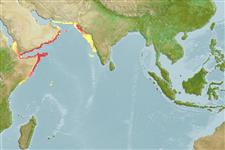Classification / Names
Common names | Synonyms | Catalog of Fishes(genus, species) | ITIS | CoL | WoRMS | Cloffa
Teleostei (teleosts) >
Perciformes/Scorpaenoidei (Scorpionfishes) >
Scorpaenidae (Scorpionfishes or rockfishes) > Pteroinae
Etymology: Parapterois: Greek, para = the side of + Greek, pterois, derived from pteron = wing, fin (Ref. 45335).
More on author: Alcock.
Environment: milieu / climate zone / depth range / distribution range
Ecology
Marine; benthopelagic; depth range 64 - 430 m (Ref. 95026). Tropical
Indian Ocean: west coast of India. Also from Oman ans Somalia (Ref. 95026).
Size / Weight / Age
Maturity: Lm ? range ? - ? cm
Max length : 12.4 cm SL male/unsexed; (Ref. 95026)
Short description
Morphology | Morphometrics
This species is distinguished by the following characters: no scales on midline of interorbital space throughout life; longitudinal scale series 43-49 (mean 45.9); head length 39.7-44.1% (42.4%) of SL; snout length 12.9-19.1% (15.8%) of SL; head depth 21.0-25.1% (23.0%) of SL; tip of tentacle on posterior spine of lacrimal not extending beyond level of posterior margin of maxilla (sometimes extending slightly beyond in juveniles); upper margin of orbit higher than or level with base of first dorsal spine (in lateral view) in adults, lower than in young; top of bulge on snout well below ventralmost margin of orbit (in lateral view) in adults, located between levels of ventralmost margins of pupil and orbit in young (Ref. 54479).
Life cycle and mating behavior
Maturity | Reproduction | Spawning | Eggs | Fecundity | Larvae
Motomura, H., 2004. Morphological comparison of a poorly known scorpionfish, Parapterois macrura, with a related species, P. heterura (Scorpaenidae: Pteroinae). Zool. Stud. 43(1):1-7. (Ref. 54479)
IUCN Red List Status (Ref. 130435)
Threat to humans
Harmless
Human uses
More information
Common namesSynonymsMetabolismPredatorsEcotoxicologyReproductionMaturitySpawningSpawning aggregationFecundityEggsEgg development
Age/SizeGrowthLength-weightLength-lengthLength-frequenciesMorphometricsMorphologyLarvaeLarval dynamicsRecruitmentAbundanceBRUVS
ReferencesAquacultureAquaculture profileStrainsGeneticsElectrophoresesHeritabilityDiseasesProcessingNutrientsMass conversion
Tools
Special reports
Download XML
Internet sources
Estimates based on models
Preferred temperature (Ref.
123201): 14.2 - 20.2, mean 17.7 °C (based on 27 cells).
Phylogenetic diversity index (Ref.
82804): PD
50 = 0.7500 [Uniqueness, from 0.5 = low to 2.0 = high].
Bayesian length-weight: a=0.01023 (0.00444 - 0.02358), b=3.01 (2.82 - 3.20), in cm total length, based on LWR estimates for this (Sub)family-body shape (Ref.
93245).
Trophic level (Ref.
69278): 3.7 ±0.6 se; based on size and trophs of closest relatives
Resilience (Ref.
120179): Medium, minimum population doubling time 1.4 - 4.4 years (Preliminary K or Fecundity.).
Fishing Vulnerability (Ref.
59153): Low vulnerability (10 of 100).
